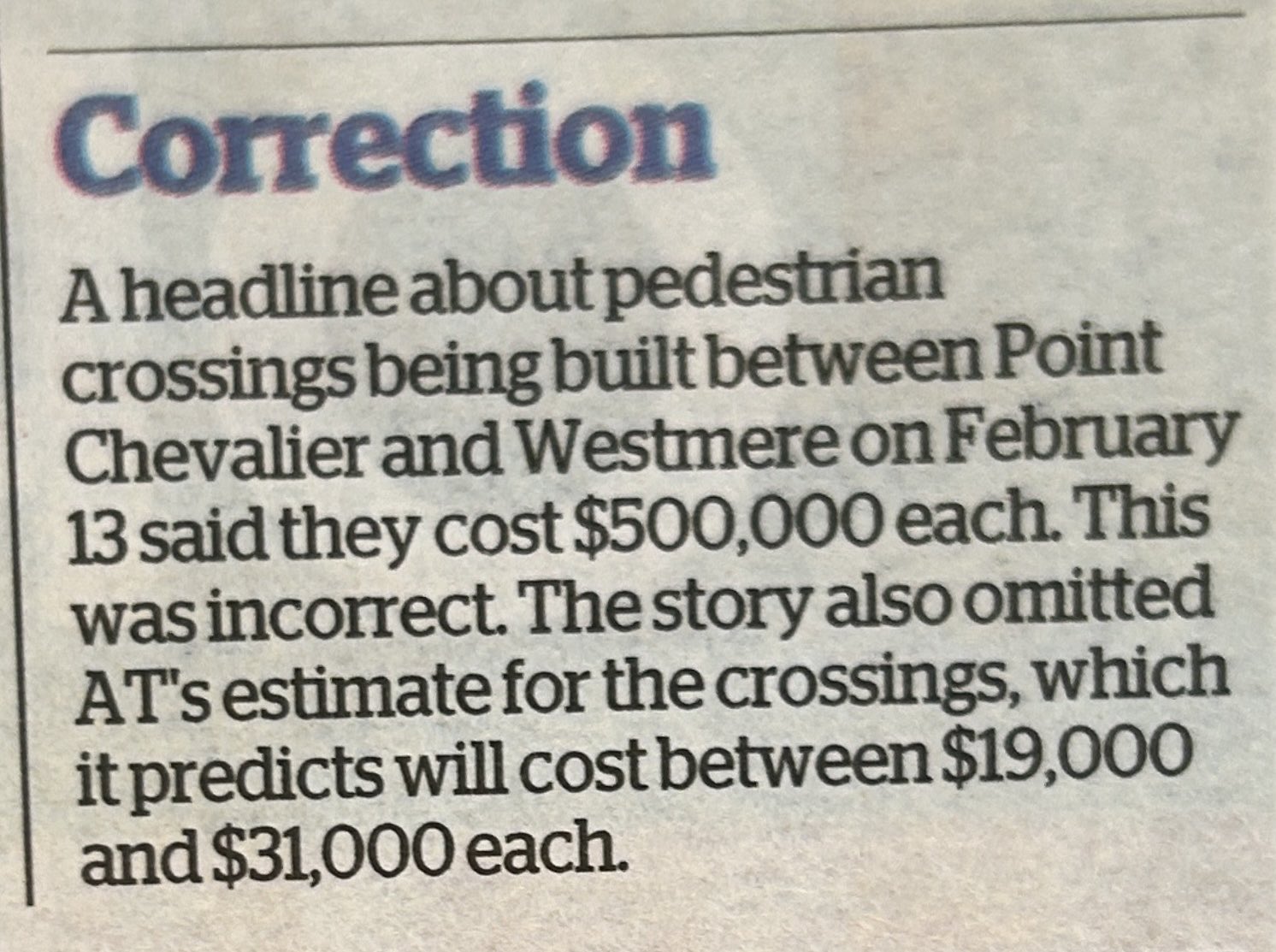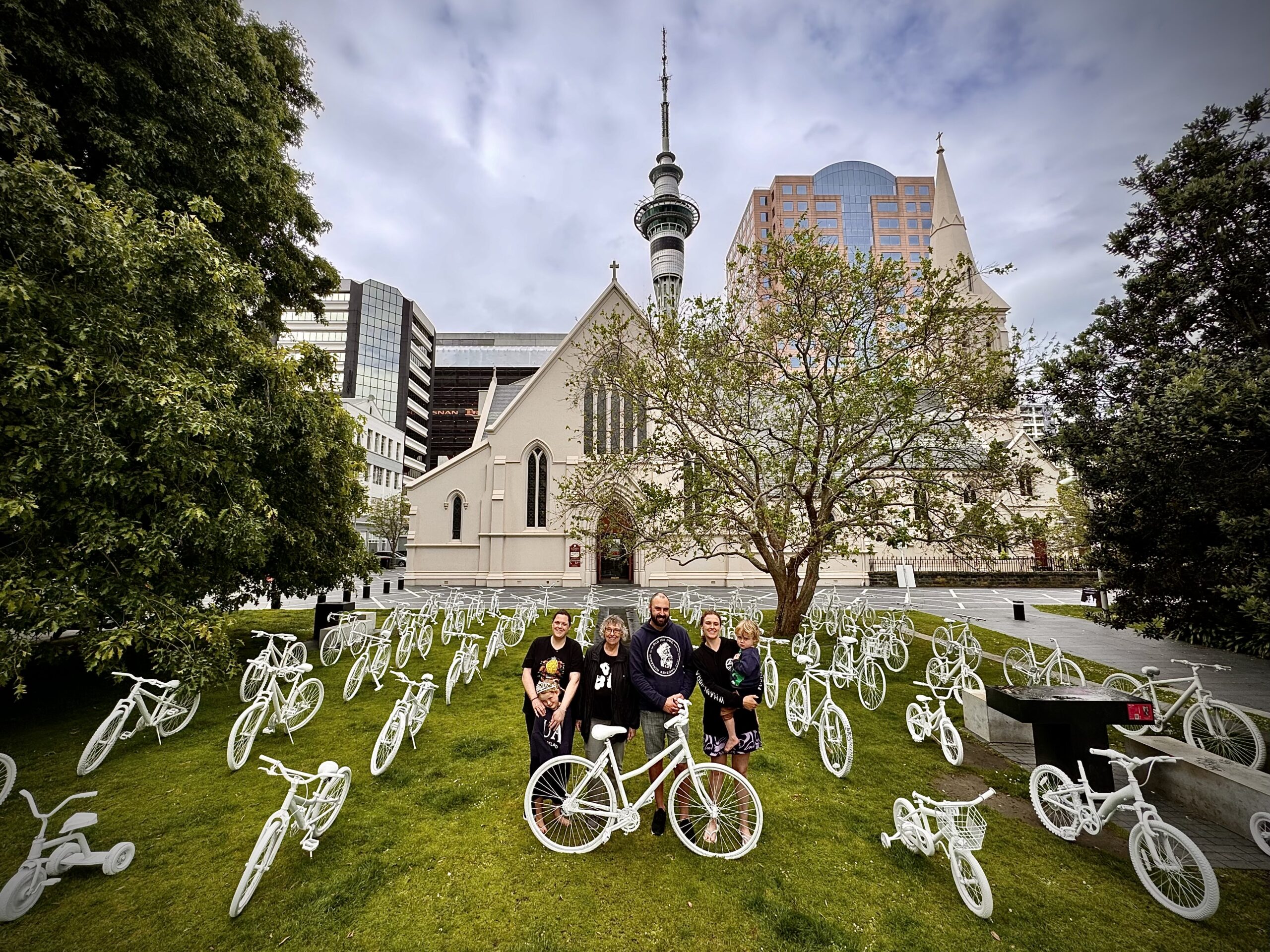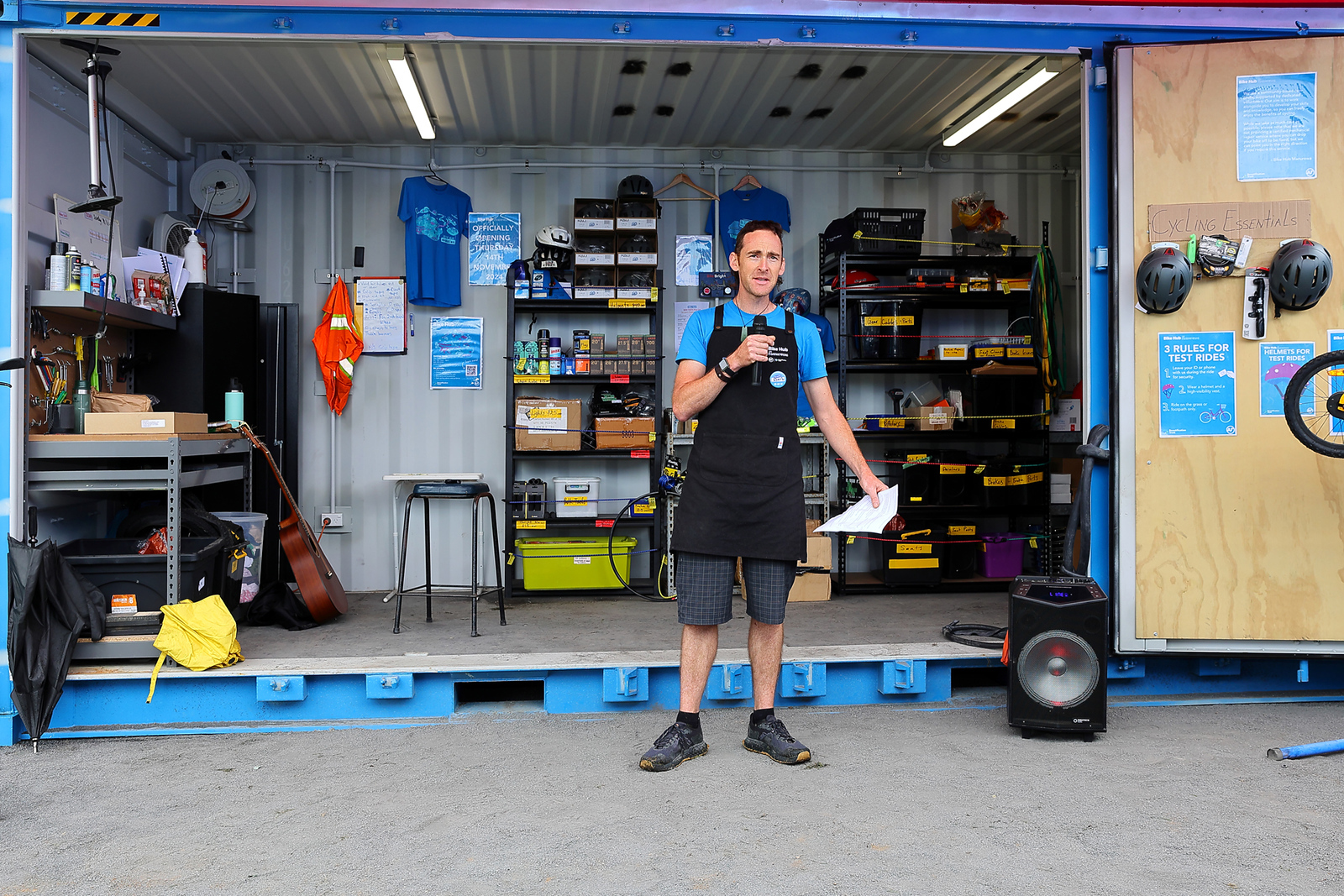There’s been a lot of confusion in the media recently, especially surrounding raised pedestrian crossings. Bike Auckland has put together some crucial facts about these projects to help clear things up, and we send our love towards raised crossings for the amazing accessibility and safety they bring to our communities.

The Point Chevalier to Westmere Improvements Project
Meola Road, and the Point Chevalier to Westmere Improvements Project, is a hot topic again! This time with some misinformation about the cost of its raised crossings.
For a quick recap on this project which was first raised to the public in 2017, and the drama which caused it to almost grind to a halt in 2023, check out this article or our campaign page.
Bike Auckland have made a quick run down of the key facts, to help clear up some of the recent confusion.
The short version…
- The majority of the raised crossings are $19,000, with a few larger raised crossings at $31,000. This is well below the $500,000 which Bernard Orsman originally reported in the Herald.
- Auckland Transport is delivering this project 38% cheaper than originally forecasted
- The most recent public consultation found 10:1 are in favour of protected bike lanes and 5:1 in favour of pedestrian improvements. Consultation has consistently shown high support for improved safety, raised crossings, and protected cycleways.
- A local student-led petition gained 2657 signatures in support of installing raised crossings. The students also advocated to the local board and Council for improved safety for students walking and cycling in this area.
- The project is supported by more than 50 organisations including the local schools along the route.
The long version…
On 13 February 2024 a Herald article written by Bernard Orsman erroneously stated that the raised crossings for this project were costing $500,000 each. The article has now been corrected: the raised crossings in this project are predicted to be mostly $19,000, with a few of the larger ones costing $31,000, significantly less than the number previously stated.
[Update: Auckland Transport have confirmed that the correct figures were supplied to the Herald before the publication date of the article, which begs the question as to why the article was first published with the incorrect price, and why it took so long to be corrected]
Concerningly, this misleading journalism was parroted by other media outlets and the general public without question, before being corrected by the Herald. RNZ has also issued a correction but there are still radio shows repeating the incorrect figures – this misinformation seems to have already embedded itself into public consciousness.

The raised crossings were overwhelmingly supported in the consultation for the project, with 2657 signatures on a student-led petition. There is one crossing which Auckland Transport is considering leaving as a road-level zebra crossing, as a further cost cutting measure, which would be a huge safety loss for the area.
[Update: we have received news that this will be retained as designed, to be built as a raised crossing, leading to safer outcomes for all who use these streets]
The entire project’s cost has been reduced to $29.3million, from a previous forecast of $47.5million. This saving of $18.2million is an amazing achievement by Auckland Transport, especially during a time of high infrastructure prices and transport budgets being slashed. $400,000 of this has been saved by extending the Meola Road general traffic closure until April 2024, reducing traffic management costs, and enabling the works to be completed 2 months earlier than originally planned.
Note: Meola Road’s southern footpath remains open for people walking, biking, and wheeling. You can still walk, bike, or scooter between Pt Chevalier and Westmere, including to Seddon Fields and the dog park. It’s a great opportunity to see the works in action, especially for young enthusiasts of diggers and rollers.
Where did this 500,000 number come from?
The figure was quoted in another Bernard Orsman piece in the Herald (paywalled sorry) as a comparison of how much crossings cost in Tāmaki Makaurau Auckland compared to Pōneke Wellington. To make his point, Orsman compared just two crossings: one unusually costly rebuild of a raised table (due to drainage issues) in Tāmaki Makaurau Auckland, with an equally unusual example in Pōneke Wellington.
The short version…
| The two raised tables | Full price | Material | Lifespan |
| Pōneke Wellington (Hataitai) | $570,000 | Asphalt | 10 years |
| Tāmaki Makaurau Auckland (Williamson Ave, Grey Lynn) | $490,000 | Concrete | 40 years |
The long version…
On 24 January 2024, a Herald article by Bernard Orsman asserted that raised crossings built in Tāmaki Makaurau Auckland are much much more expensive than those built in Pōneke Wellington.
The two cherry-picked crossings that the article is comparing are…
- Williamson Avenue in Grey Lynn, Tāmaki Makaurau: a raised crossing built from concrete. According to an earlier article by Orsman, it was originally built for a cost of $346,000 but then had to be dug up and re-built due to substandard quality faults – with the full cost coming to $490,000 (including storm water upgrades and lighting).
- Hataitai, Pōneke Wellington: a raised crossing built from asphalt. Orsman’s article asserts that this crossing was built for $40,000. However, Auckland Transport said that this was the price of only the pedestrian table, while the full cost of the raised crossing was $570,000 (including storm water upgrades and lighting).
It definitely doesn’t make sense to compare the cost of one part of a project with the full cost of another. This is an incredibly misleading comparison. On top of this, the Pōneke crossing is made from asphalt, which needs to be replaced again in 10 years, while the Tāmaki Makaurau crossings are made from concrete and last 40 years. These are vastly different in terms of long term sustainability, and ongoing maintenance costs. It doesn’t make sense to compare the upfront cost of these crossings, but it could make sense to compare the longer term cost over time.
To compare costs in an accurate way Orsman would need to look at a much much larger (statistically significant) amount of crossings across both regions, and account for differences in materials and scope of projects (eg. whether they include storm water and lighting). We could say that Tāmaki Makaurau Auckland is the winner in this particular bizarre price comparison because we are building longer lasting infrastructure, saving money over a longer span of time.
While this article was very confused, it’s even more concerning that Mayor Wayne Brown seemingly began to take action against raised crossings without clarifying the actual infrastructure costs and how ours compare to other cities.
There are opportunities for Auckland Transport to reduce costs for infrastructure projects; such as by fully closing the road while they work on the project, the way they have with Meola Road, saving $400,000 on traffic management costs. Auckland Transport is also working to reduce costs by using pre-cast concrete tables for applicable projects.
Why does Bike Auckland care about crossings?
There’s an abundance of evidence that raised crossings make the road safer for everyone, and significantly reduce the frequency and severity of crashes. This improvement in safety is for everyone who uses the road, including people driving and riding bikes too.
Raised crossings also improve accessibility. Because they are the same height as the footpaths (no curb cut to navigate), they make it easier and safer for everyone to cross the road, but especially for children, physically disabled people, people using pushchairs, people with visual impairments, and intellectually disabled people.
Raised crossings form an important part of our cycle network too. Quiet streets can be a wonderful place to ride a bike on the way from A to B (especially with friends!) but there are often busy roads that need to be crossed to get to the next swathe of quiet streets. Raised crossings give people riding bikes a way to safely, easily cross these busier roads to get to the next patch of quiet street.
Raised crossings are effective at encouraging drivers to slow down and take more time to look before they continue along the road. This momentary pause means people driving are more likely to notice people walking, cycling, and wheeling – and mean people are less likely to be seriously harmed if there is a crash, keeping everyone on the road safer!
Drop us a line and let us know about your favourite raised crossing, or a spot that needs one! You can read more about raised crossings and raised tables in this article by our friends at Greater Auckland.



